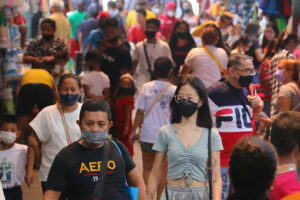CORONAVIRUS infections in some parts of the Philippines including the main island of Luzon have increased, though still not at an alarming level, according to the OCTA Research Group.
The infection rate in Calabarzon, Central Luzon, Western Visayas, Pangasinan and La Union have had increased, Fredegusto P. David, a fellow from the OCTA Research Group, told a news briefing on Tuesday.
Infections in the provinces of Cagayan, Isabela, Iloilo, Pampanga, Bulacan, Bataan, Nueva Ecija and Tarlac have also spiked, he said.
“We have monitored rising cases in most of Calabarzon except Quezon, but this is not alarming,” Mr. David said in Filipino. “We just want the public to be aware that cases in these areas have increased and we need to be safe.”
He said health authorities are looking at the country’s healthcare use rate to ensure it doesn’t get bogged down by rising infections.
The Philippines posted 14,640 coronavirus infections in the past week, with a daily average of 2,091 cases, the Department of Health (DoH) said on Monday.
The daily average from July 11 to 17 rose by 44% from a week earlier, according to a DoH bulletin. Of the new patients, 35 were severe and critical, it added.
One death was confirmed in the past week, but there were no deaths from July 4 to 17, the agency said.
It added that 481 of 2,630 intensive care unit (ICU) beds had been used as of July 18, while 5,189 of 21,809 non-ICU beds were occupied. There were 589 severe and critical admissions.
The coronavirus infection rate in the Philippines has increased in recent weeks, sparking discussions on whether it is safe to enforce face-to-face classes by November.
Mr. David expects about 2,000 daily coronavirus infections in the next few days, though it seemed to have peaked in Metro Manila.
He traced rising infections to more contagious Omicron subvariants and people’s failure to observe minimum health standards.
More than 70 million Filipinos have been fully vaccinated against the coronavirus, with more than 15 million having received a booster shot.
Meanwhile, President Ferdinand R. Marcos, Jr. has decided to keep the country’s five-tier COVID-19 alert system, as he awaits a new classification scheme by next month, according to the presidential palace.
“To avoid confusion, we will retain the alert level system for now,” Mr. Marcos told DoH officer-in-charge Maria Rosario S. Vergeire at a recent meeting, based on a press release sent by Malacañang.
“We are studying very closely, and we’ll come to a decision very soon as to decoupling the restrictions from the alert levels,” the president said.
Mr. Marcos met with Ms. Vergeire and other Health officials on Monday to discuss the government’s pandemic plan.
Ms. Vergeire said DoH might release new classifications by the second week of August, when more restrictions will have been eased.
Mr. Marcos, who has vowed to ditch lockdowns, wants the new restrictions to be compatible with the milder variants of the coronavirus, the palace said.
It noted that among the factors being considered for easing of restrictions is the country’s low booster uptake
Mr. Marcos at the weekend said his government would start a campaign to encourage more Filipinos to get booster shots against the coronavirus.
The program is part of the preparations for face-to-face classes and full economic reopening, he said in his latest video blog.
The Health, the Interior and Local Government, and Education departments would lead the campaign to increase the country’s booster uptake, he said.
Mr. Marcos, 64, recently finished his seven-day isolation on Friday after he tested positive for the coronavirus.
Most areas in the Philippines including the capital region are under the lowest virus alert, allowing businesses to operate at full capacity. — Norman P. Aquino and Kyle Aristophere T. Atienza

